In Situ Measurement of Spindle Radial Error for Ultra-Precision Machining Based on Three-Point Method
Abstract
1. Introduction
2. Mathematical Model and Error Separation Technology
2.1. Mathematical Model of the Circular Cross-Sectional Profile
2.2. Error Separation Techniques
2.2.1. Three-Point Method
2.2.2. Donaldson Reversal Method
3. Design of In Situ Measurement and Evaluation System
3.1. Overall Structure of In Situ Measurement and Evaluation System
3.2. Design of Fixture and Standard Workpiece
3.2.1. Design of Fixture
3.2.2. Design of Standard Workpiece
3.2.3. Determination of Sampling Points
4. In Situ Measurement and Evaluation Experiment of Radial Error
4.1. In Situ Measurement and Evaluation Experiment of Radial Error Using Three-Point Method
4.2. Comparative Experiment of the Results
5. Result and Discussion
6. Conclusions
Author Contributions
Funding
Data Availability Statement
Conflicts of Interest
References
- Yuan, J.; Lyu, B.; Hang, W.; Deng, Q. Review on the progress of ultra-precision machining technologies. Front. Mech. Eng. 2017, 12, 158–180. [Google Scholar] [CrossRef]
- Zhang, S.; To, S.; Wang, S.; Zhu, Z. A review of surface roughness generation in ultra-precision machining. Int. J. Mach. Tools Manuf. 2015, 91, 76–95. [Google Scholar] [CrossRef]
- Chen, G.; Sun, Y.; Zhang, F.; An, C.; Chen, W.; Su, H. Influence of ultra-precision flycutting spindle error on surface frequency domain error formation. Int. J. Adv. Manuf. Technol. 2017, 88, 3233–3241. [Google Scholar] [CrossRef]
- Chen, G.; Sun, Y.; An, C.; Zhang, F.; Sun, Z.; Chen, W. Measurement and analysis for frequency domain error of ultra-precision spindle in a flycutting machine tool. Proc. Inst. Mech. Eng. Part B J. Eng. Manuf. 2018, 232, 1501–1507. [Google Scholar] [CrossRef]
- Gao, W.; Kiyono, S.; Satoh, E.; Sata, T. Precision Measurement of Multi-Degree-of-Freedom Spindle Errors Using Two-dimensional Slope Sensors. CIRP Ann. 2002, 51, 447–450. [Google Scholar] [CrossRef]
- Geng, Z.; Tong, Z.; Jiang, X. Review of geometric error measurement and compensation techniques of ultra-precision machine tools. Light Adv. Manuf. 2021, 2, 211–227. [Google Scholar] [CrossRef]
- Aoki, Y.; Ozono, S. On a New Method of Roundness Measurement Based on the Three-point Method. J. Jpn. Soc. Precis. Eng. 1966, 32, 831–836. [Google Scholar] [CrossRef]
- Whitehouse, D.J. Some theoretical aspects of error separation techniques in surface metrology. J. Phys. E Sci. Instrum. 1976, 9, 531–536. [Google Scholar] [CrossRef]
- Chetwynd, D.G.; Siddall, G.J. Improving the accuracy of roundness measurement. J. Phys. E Sci. Instrum. 1976, 9, 537–544. [Google Scholar] [CrossRef]
- Donaldson, R.R. A simple method for separating spindle error from test ball roundness error. Ann. CIRP 1972, 21, 125. [Google Scholar]
- Liu, X.; Rui, X.; Mi, L.; Tang, Q.; Chen, H.; Xia, Y. Radial Error Motion Measurement and Its Uncertainty Estimation of Ultra Precision Axes of Rotation with Nanometer Level Precision. Micromachines 2022, 13, 2121. [Google Scholar] [CrossRef]
- Cui, H.; Lei, D.; Zhang, X.; Lan, H.; Jiang, Z.; Kong, L. Measurement and analysis of the radial motion error of aerostatic ultra-precision spindle. Measurement 2019, 137, 624–635. [Google Scholar] [CrossRef]
- Cheng, H.; Hu, Q.; Xu, Y. Uncertainty evaluation of aerostatic spindle rotation accuracy by donaldson reversal method. Modul. Mach. Tool Autom. Manuf. Tech. 2017, 58, 10–13+17. [Google Scholar] [CrossRef]
- Jozwik, J. Dynamic Measurement of Spindle Errors of CNC Machine Tools by Capacitive Sensors During Aircraft Parts Machining. In Proceedings of the 2018 5th IEEE International Workshop on Metrology for AeroSpace (MetroAeroSpace), Rome, Italy, 20–22 June 2018; pp. 398–402. [Google Scholar] [CrossRef]
- Ding, F.; Luo, X.; Chang, W.; Wang, Z. In Situ Measurement of Spindle Radial and Tilt Error Motions by Complementary Multi-probe Method. Nanomanufacturing Metrol. 2019, 2, 225–234. [Google Scholar] [CrossRef]
- Liu, F.; Liang, L.; Xu, G.; Hou, C.; Liu, D. Four-Point Method in the Measurement and Separation of Spindle Rotation Error. IEEE/ASME Trans. Mechatron. 2021, 26, 113–123. [Google Scholar] [CrossRef]
- Marsh, E.R.; Arneson, D.A.; Martin, D.L. A Comparison of reversal and multiprobe error separation. Precis. Eng. 2010, 34, 85–91. [Google Scholar] [CrossRef]
- Marsh, E.; Couey, J.; Vallance, R. Nanometer-Level Comparison of Three Spindle Error Motion Separation Techniques. J. Manuf. Sci. Eng. 2006, 128, 180–187. [Google Scholar] [CrossRef]
- Baek, S.-W.; Kim, M.-G.; Lee, D.-H.; Cho, N.-G. Multi-probe system design for measuring the roundness and rotation error motion of a spindle using an error separation technique. Proc. Inst. Mech. Eng. Part B J. Eng. Manuf. 2019, 233, 1547–1560. [Google Scholar] [CrossRef]
- Tiainen, T.; Viitala, R. Robust optimization of multi-probe roundness measurement probe angles. Measurement 2021, 168, 108146. [Google Scholar] [CrossRef]
- Cappa, S.; Reynaerts, D.; Al-Bender, F. A sub-nanometre spindle error motion separation technique. Precis. Eng. 2014, 38, 458–471. [Google Scholar] [CrossRef]
- Gao, W.; Kiyono, S.; Nomura, T. A new multiprobe method of roundness measurements. Precis. Eng. 1996, 19, 37–45. [Google Scholar] [CrossRef]
- Gao, W.; Kiyono, S. On-machine roundness measurement of cylindrical workpieces by the combined three-point method. Measurement 1997, 21, 147–156. [Google Scholar] [CrossRef]
- Ma, Y.Z.; Wang, X.H.; Kang, Y.H.; Dong, X. Roundness Measurement and Error Separation Technique. Appl. Mech. Mater. 2013, 303–306, 390–393. [Google Scholar] [CrossRef]
- Huang, R.; Pan, W.; Lu, C.; Zhang, Y.; Chen, S. An improved three-point method based on a difference algorithm. Precis. Eng. 2020, 63, 68–82. [Google Scholar] [CrossRef]
- Jiao, Y.; Huang, M.; Liu, P. Optimal measurement angles of the three-probe spindle error motion separation technique. Meas. Sci. Technol. 2019, 30, 095001. [Google Scholar] [CrossRef]

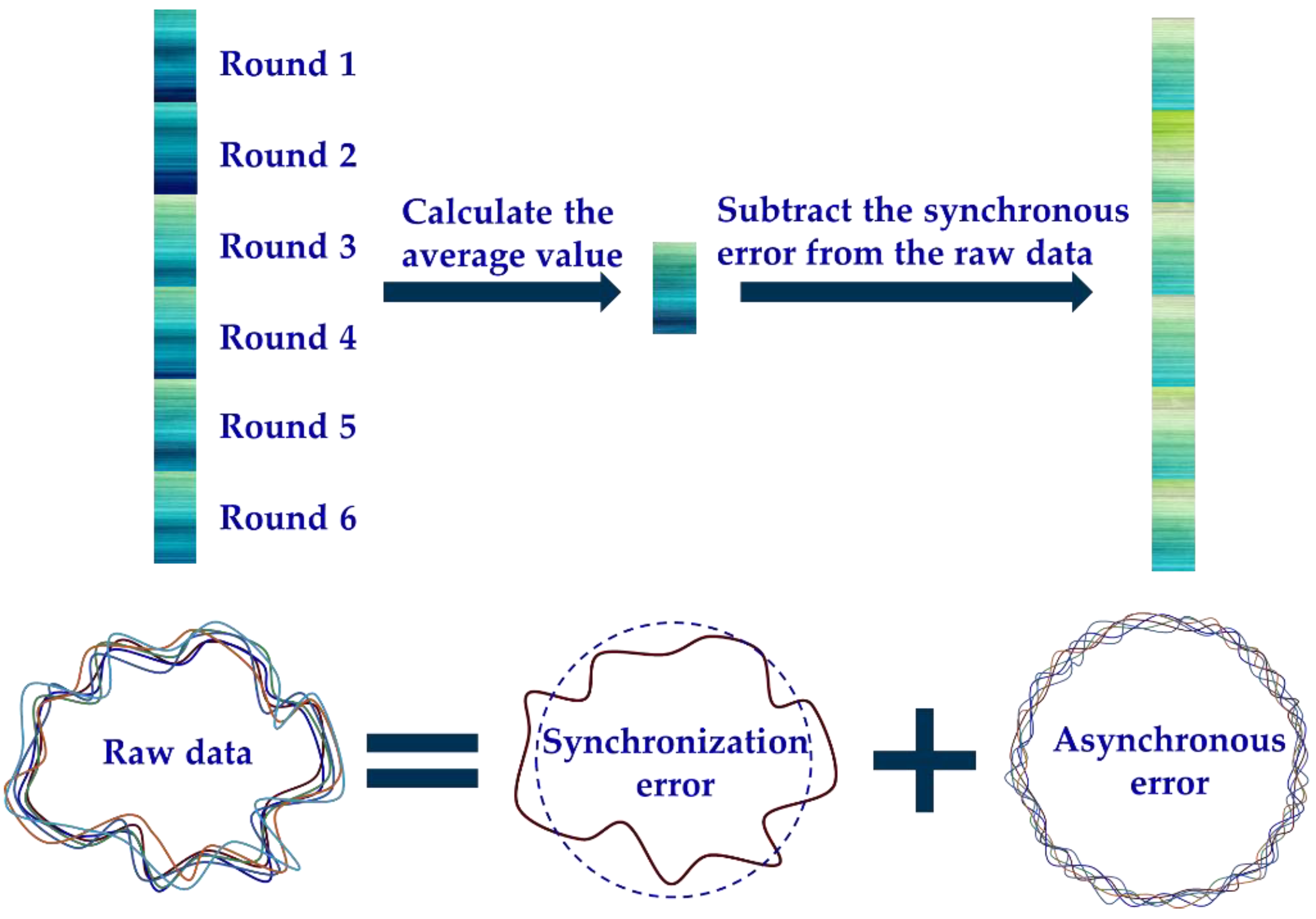
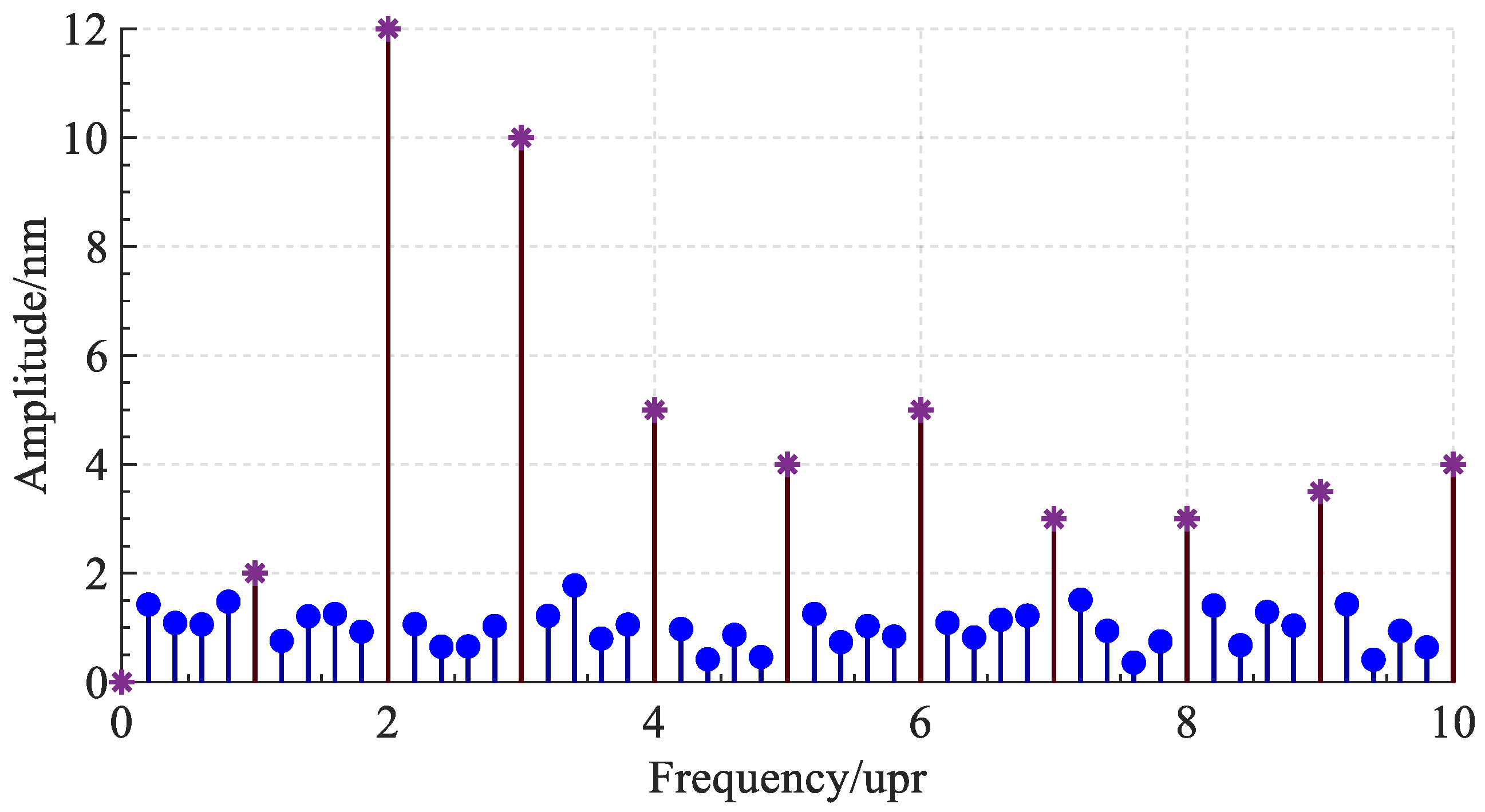
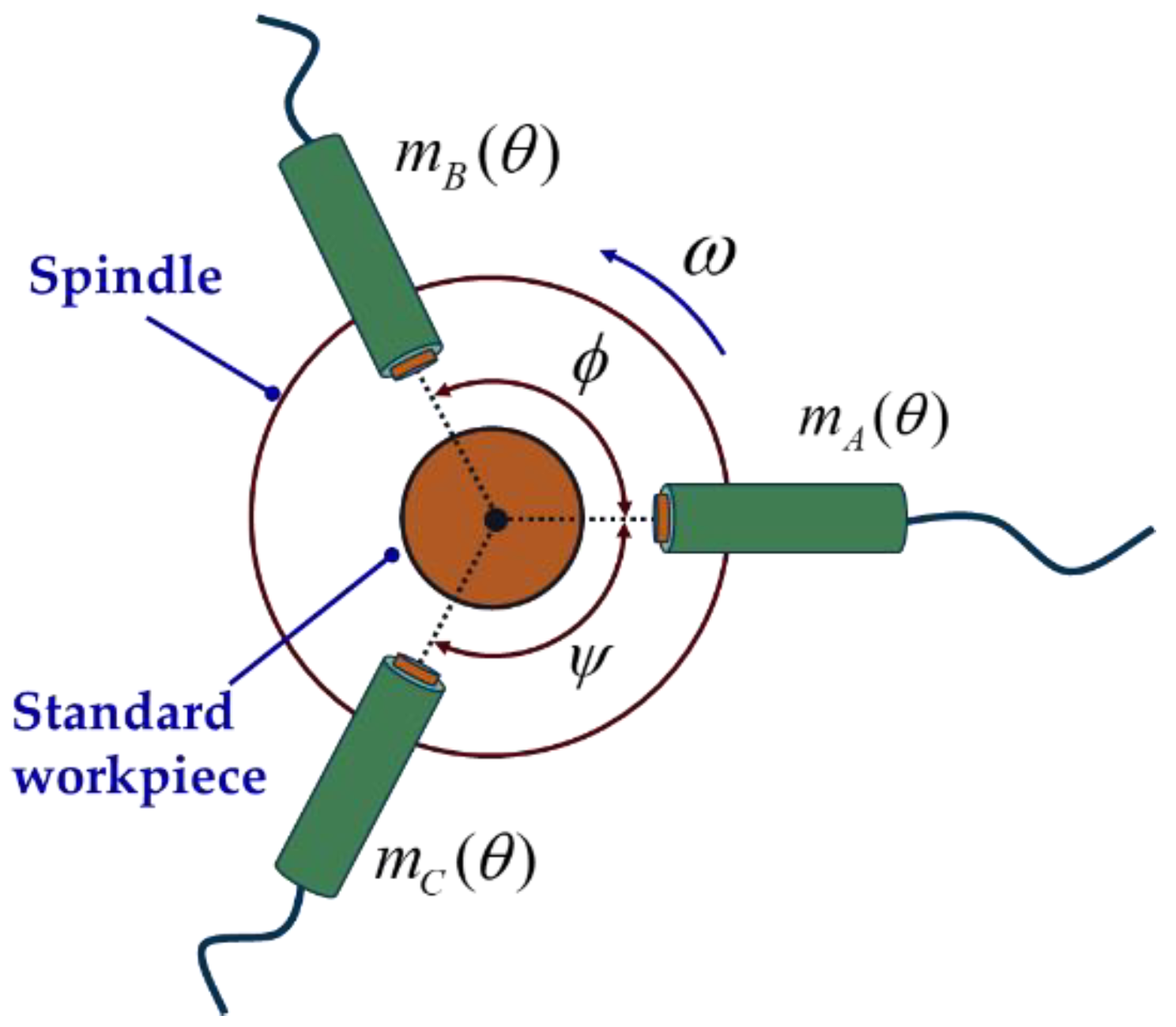
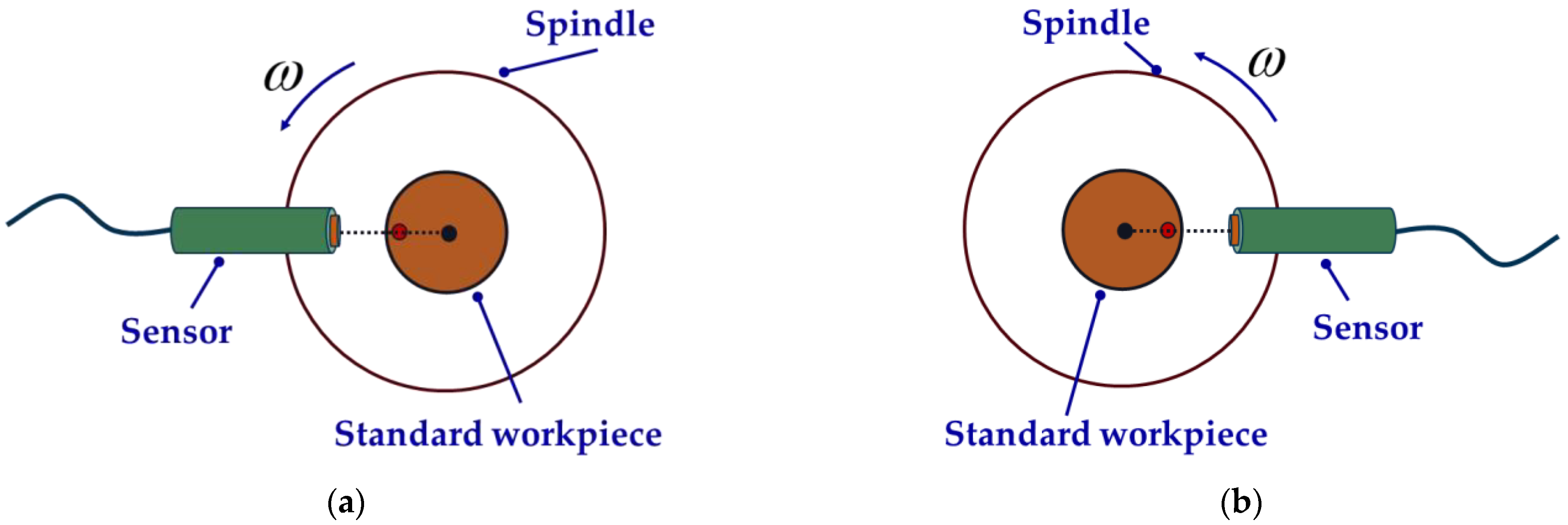
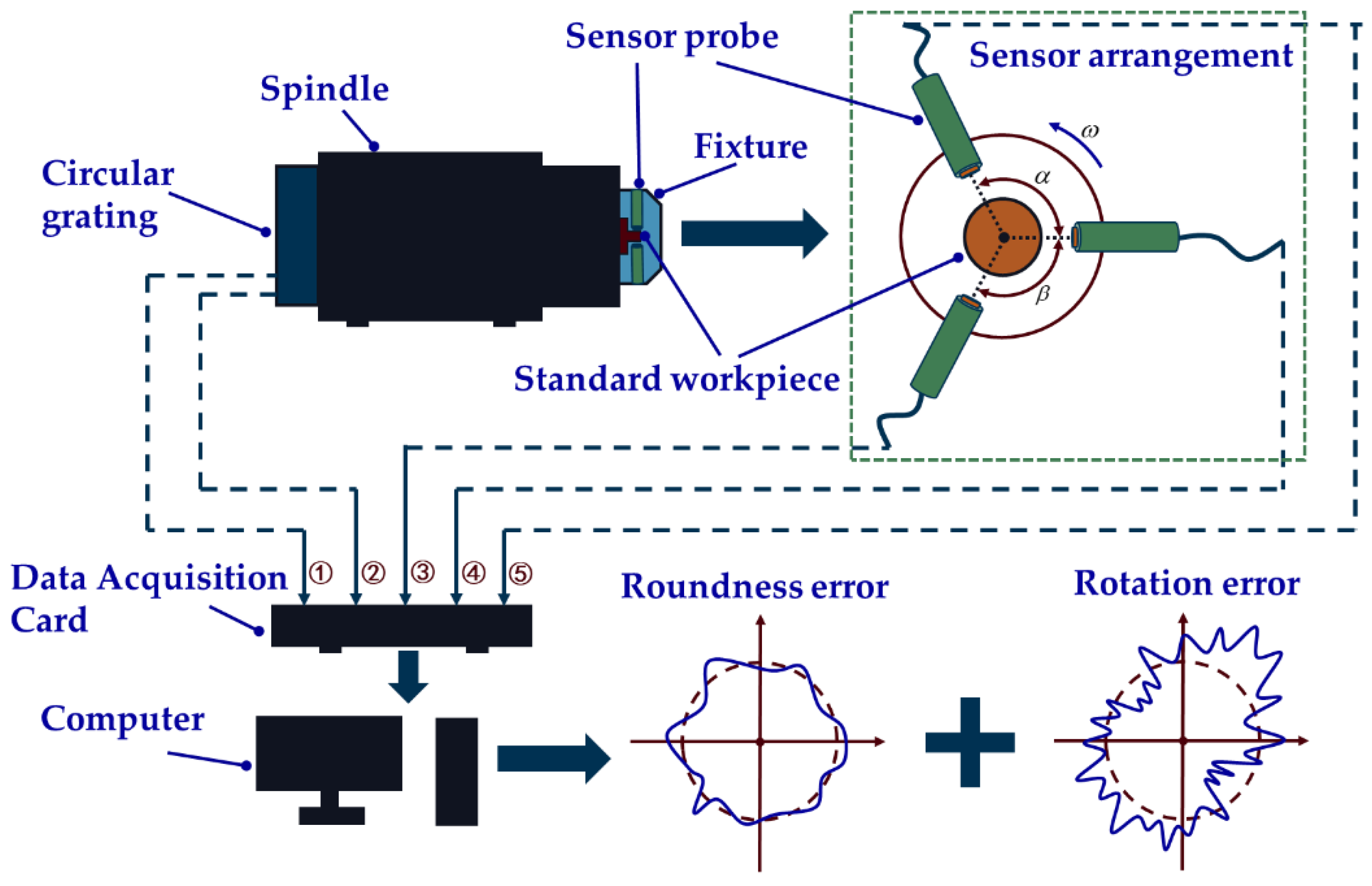

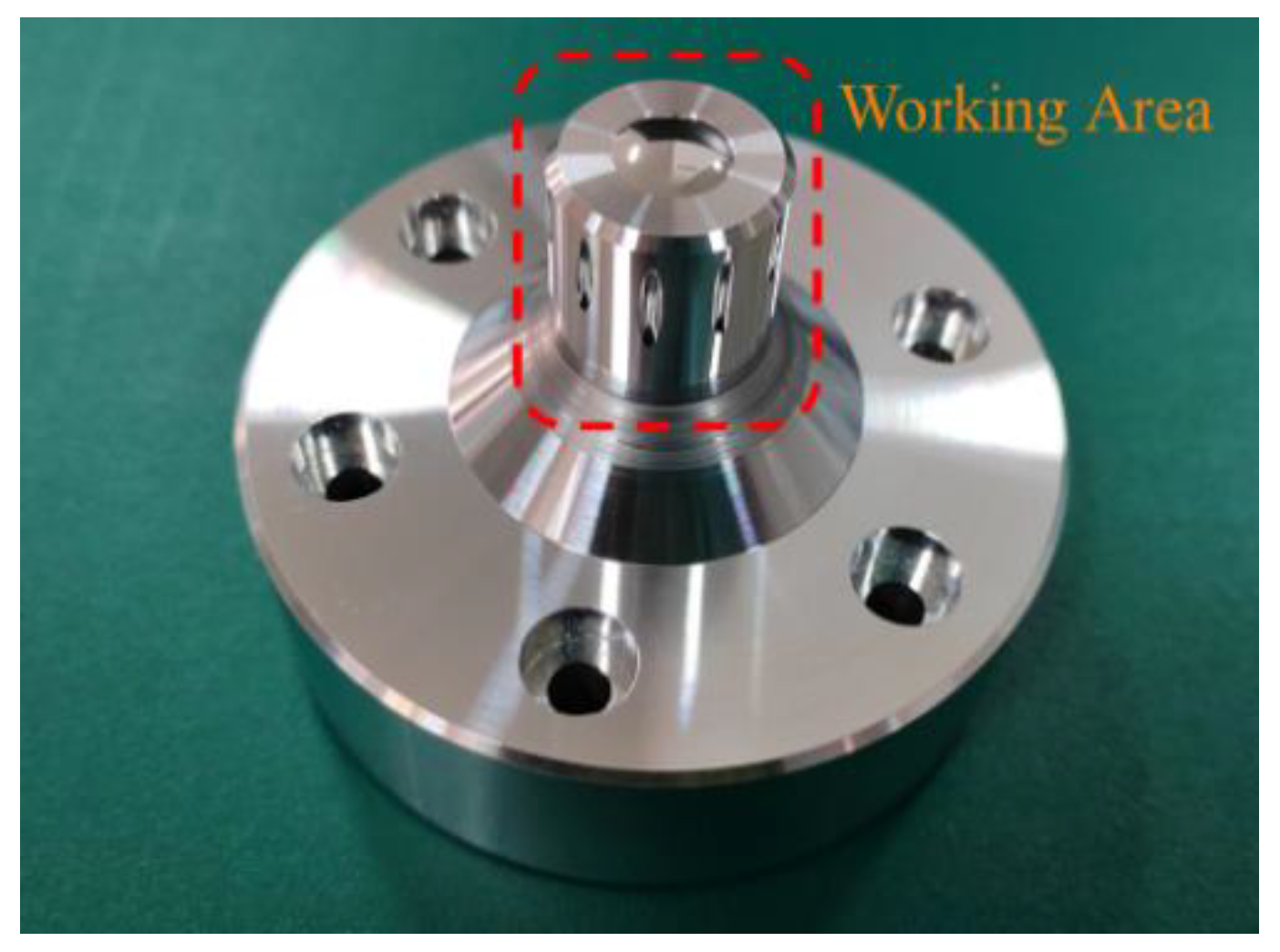
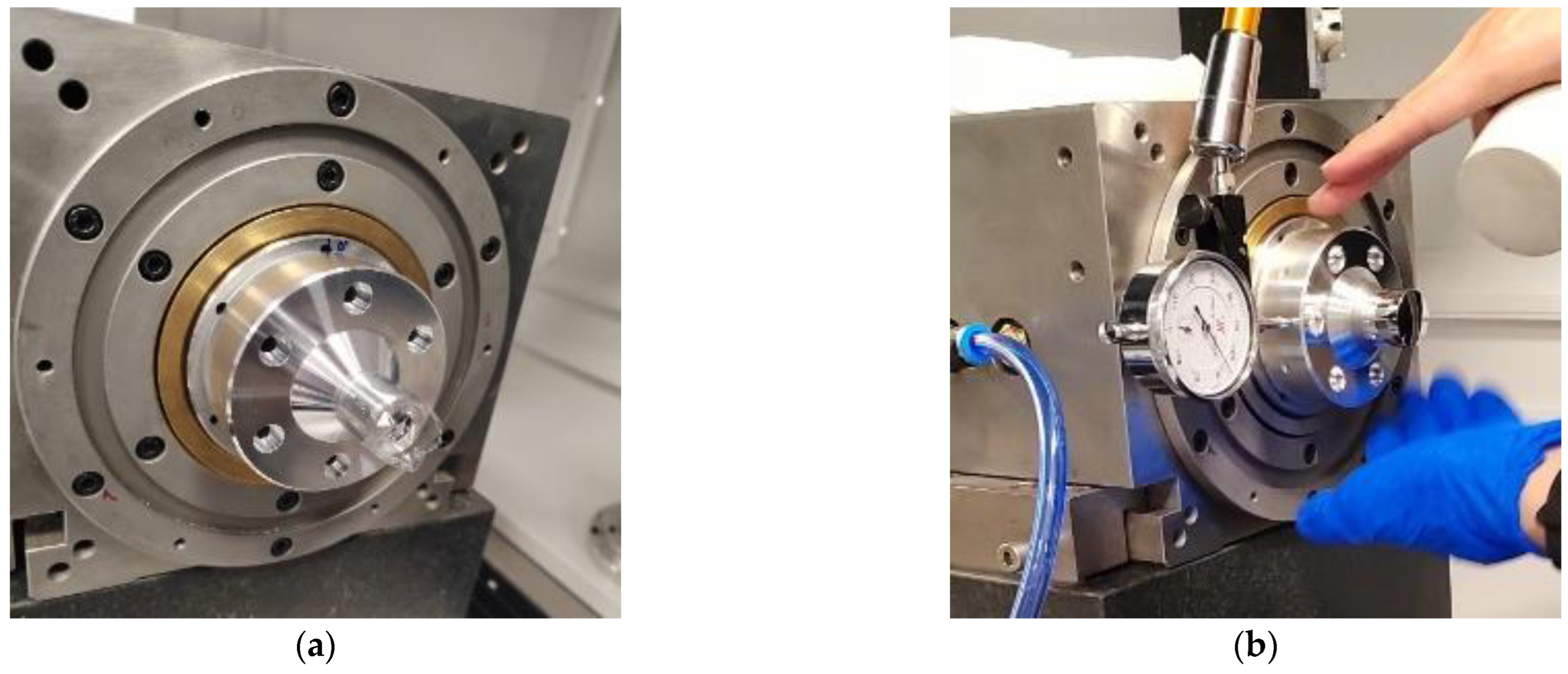
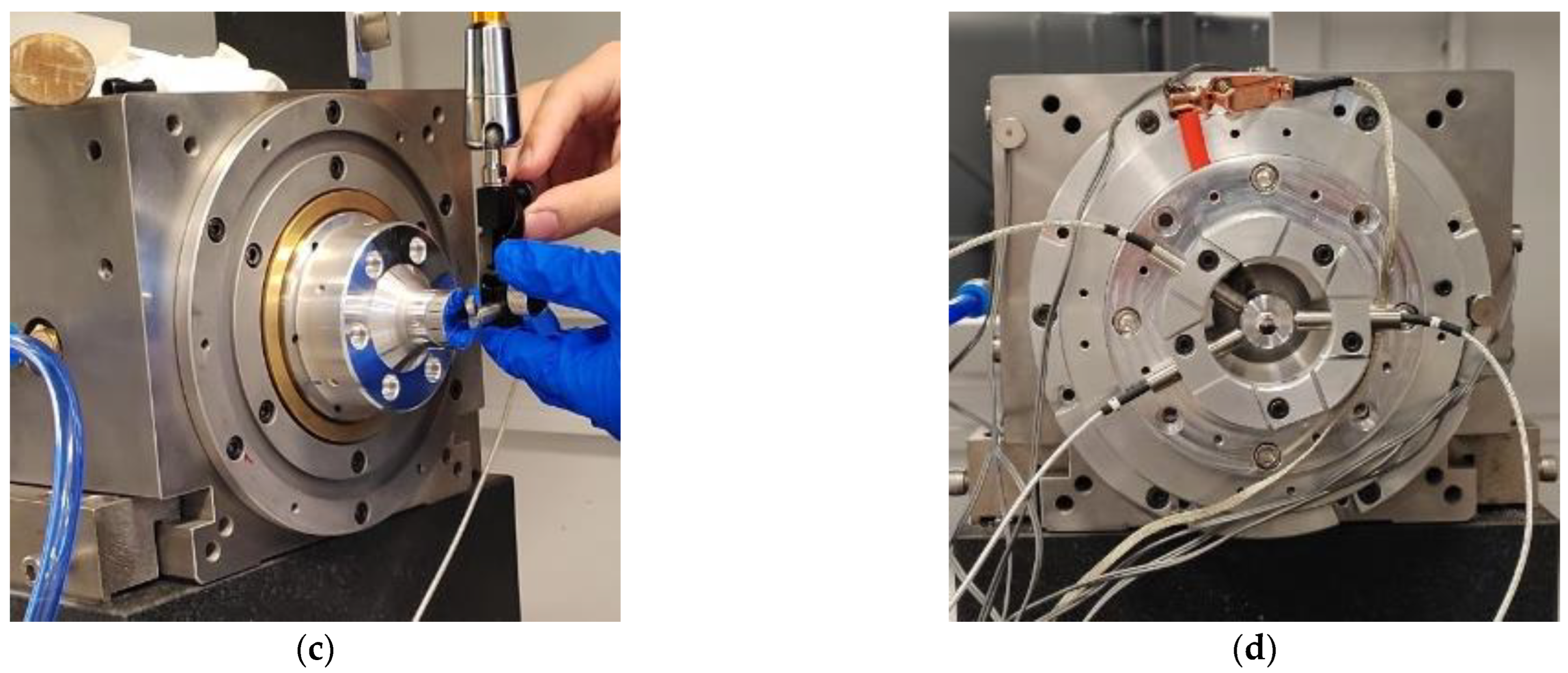
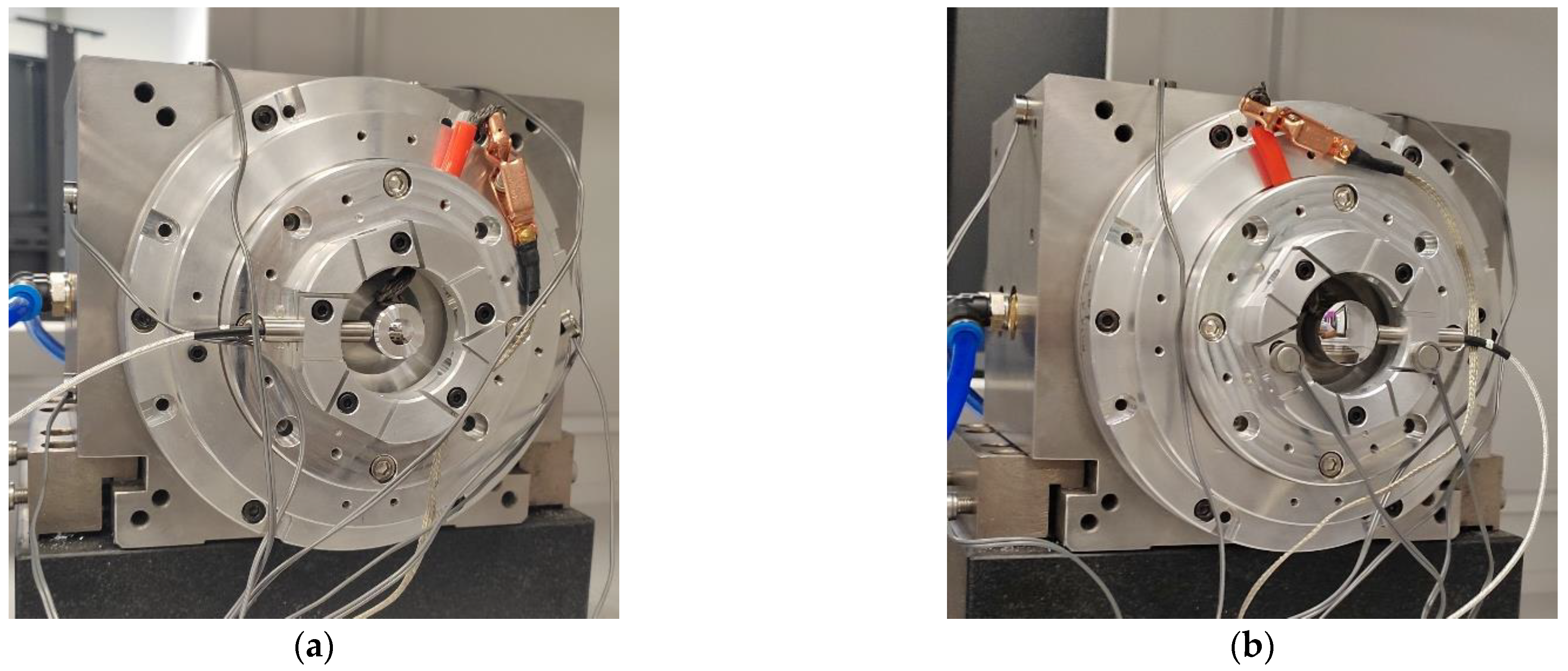
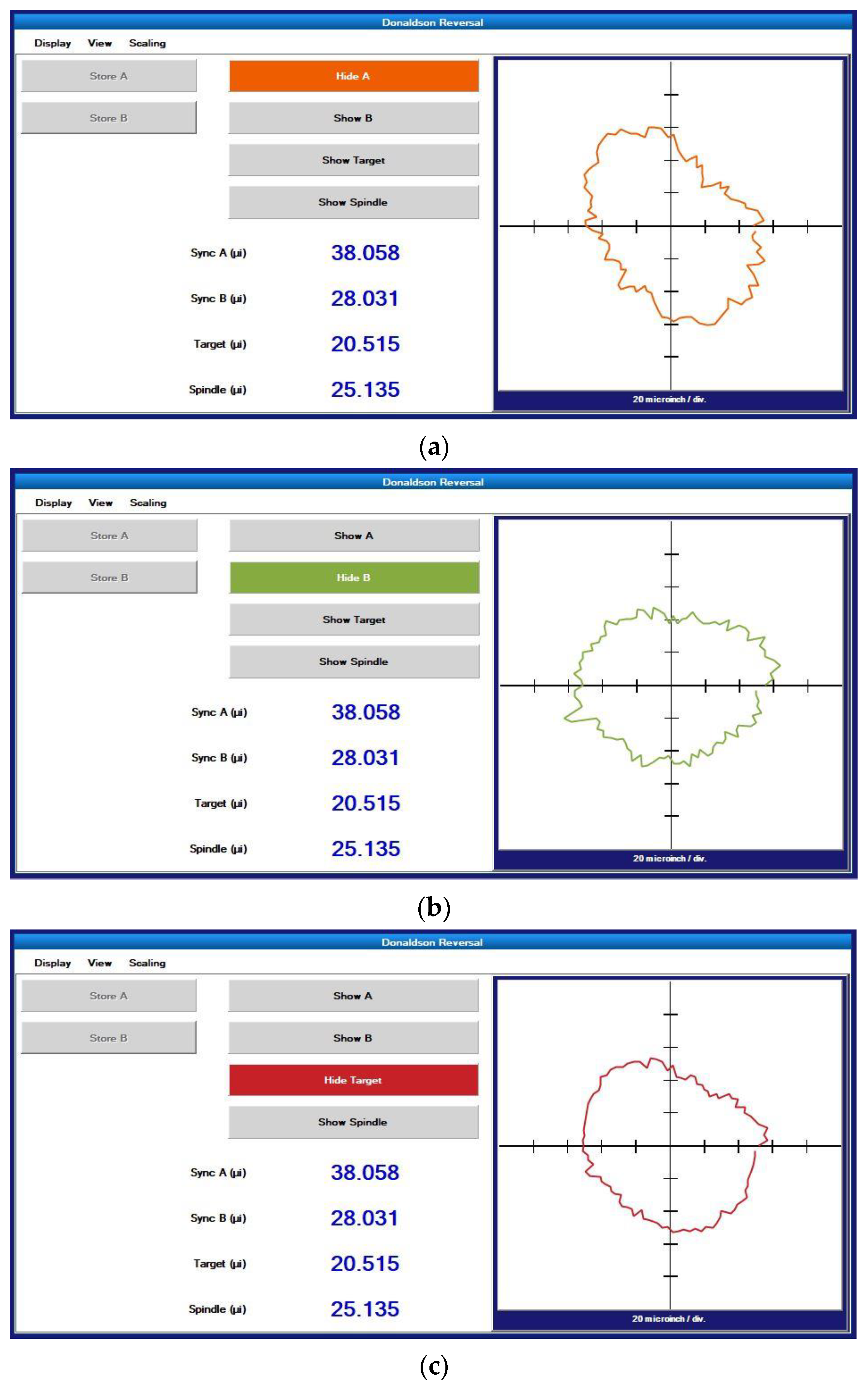
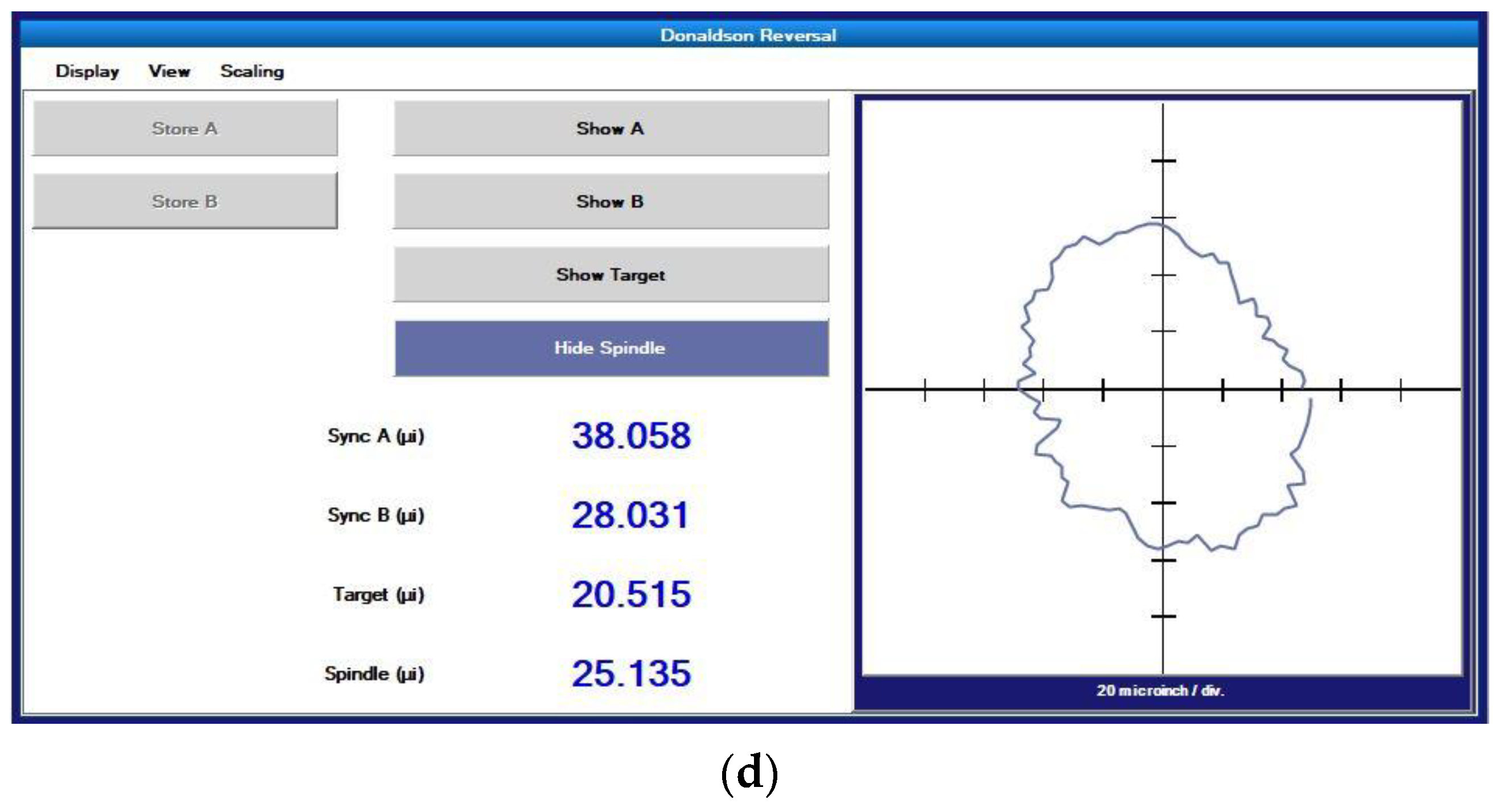
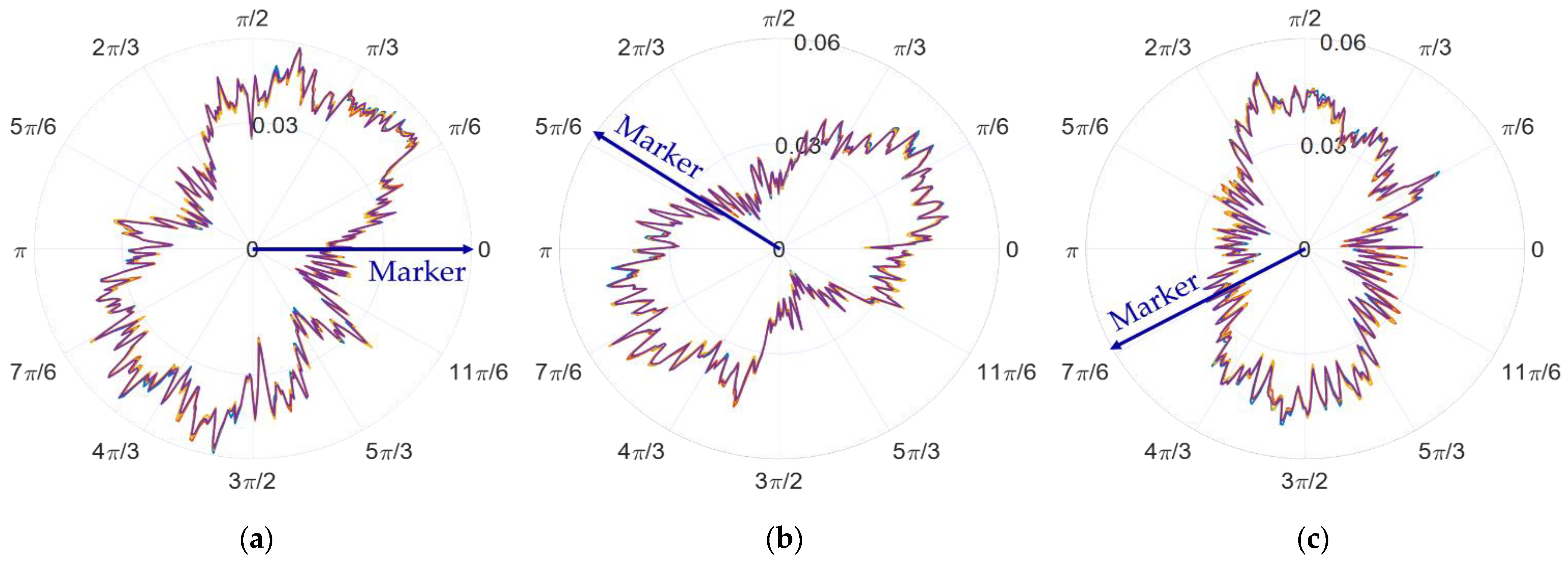


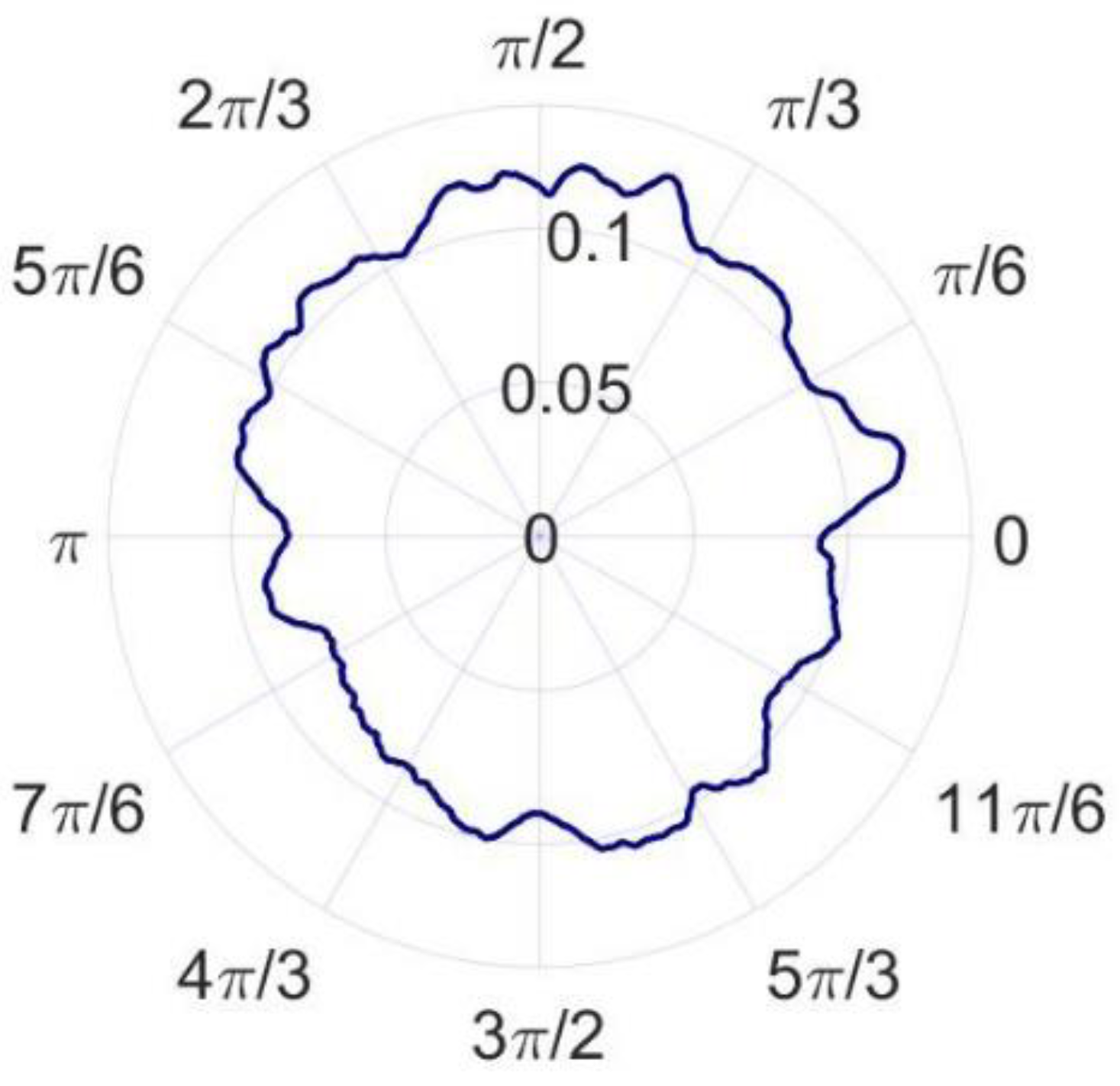

| Serial Number | Spindle Speed (rpm) | Radial Error (nm) | Roundness Error (nm) |
|---|---|---|---|
| 1 | 60 | 22.379 | 16.362 |
| 2 | 120 | 22.342 | 16.311 |
| 3 | 180 | 23.013 | 15.953 |
| 4 | 240 | 22.397 | 16.649 |
| 5 | 300 | 22.776 | 16.901 |
| 6 | 360 | 22.489 | 16.203 |
| 7 | 420 | 22.551 | 15.622 |
| 8 | 480 | 23.189 | 16.163 |
| 9 | 540 | 23.662 | 16.121 |
| 10 | 600 | 23.553 | 16.951 |
| 11 | 660 | 23.125 | 16.882 |
| 12 | 720 | 23.663 | 16.935 |
| 13 | 780 | 23.116 | 16.236 |
| 14 | 840 | 22.851 | 16.754 |
| 15 | 900 | 23.790 | 16.525 |
| 16 | 960 | 23.946 | 16.168 |
| 17 | 1020 | 23.785 | 15.828 |
Disclaimer/Publisher’s Note: The statements, opinions and data contained in all publications are solely those of the individual author(s) and contributor(s) and not of MDPI and/or the editor(s). MDPI and/or the editor(s) disclaim responsibility for any injury to people or property resulting from any ideas, methods, instructions or products referred to in the content. |
© 2023 by the authors. Licensee MDPI, Basel, Switzerland. This article is an open access article distributed under the terms and conditions of the Creative Commons Attribution (CC BY) license (https://creativecommons.org/licenses/by/4.0/).
Share and Cite
Xu, H.; Sun, Z.; Dai, Y.; Guan, C.; Hu, H.; Wang, Y. In Situ Measurement of Spindle Radial Error for Ultra-Precision Machining Based on Three-Point Method. Micromachines 2023, 14, 653. https://doi.org/10.3390/mi14030653
Xu H, Sun Z, Dai Y, Guan C, Hu H, Wang Y. In Situ Measurement of Spindle Radial Error for Ultra-Precision Machining Based on Three-Point Method. Micromachines. 2023; 14(3):653. https://doi.org/10.3390/mi14030653
Chicago/Turabian StyleXu, Hanwei, Zizhou Sun, Yifan Dai, Chaoliang Guan, Hao Hu, and Yu Wang. 2023. "In Situ Measurement of Spindle Radial Error for Ultra-Precision Machining Based on Three-Point Method" Micromachines 14, no. 3: 653. https://doi.org/10.3390/mi14030653
APA StyleXu, H., Sun, Z., Dai, Y., Guan, C., Hu, H., & Wang, Y. (2023). In Situ Measurement of Spindle Radial Error for Ultra-Precision Machining Based on Three-Point Method. Micromachines, 14(3), 653. https://doi.org/10.3390/mi14030653







